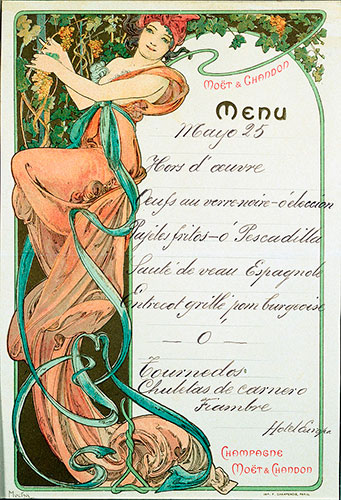Starters
Starters consist of a wide variety of hot or cold dishes served before the main course of a meal. As part of a formal dinner, they may be preceded by soup and hors d’oeuvres.
Are starters always the first course of a meal?
Nowadays, the starter is often the first course of a meal, served directly before the main course. Starters come in a wide variety and may be served hot (vol-au-vents, soufflés) or cold (cold cuts, pâtés). However, as part of a formal dinner, they may be served after the soup or the hors d’oeuvres. In this case, the starter is therefore no longer the first dish of a meal, but comes second or third in the sequence of courses. Hors d’oeuvres are smaller dishes than starters. They consist of a varied assortment of hot or cold food served at the beginning of the meal, to stimulate the appetite, without being too rich.
The evolution of starters over the centuries
The sequence of courses in a meal, from starter to main course and then dessert, seems natural nowadays. However, from the 16th century, and until the 19th century, formal dinners in France, and later in the rest of Europe, were divided into several courses, each made up of several dishes. This way of serving guests is called service à la française, or French-style service. Guests could help themselves from the various dishes served in each course. The more guests there were, the more courses there were. As a rule, with a minimum three-course meal, the first course included soups, hors d’oeuvres and starters, while the second comprised roasts, cold cuts, vegetables and entremets and the third, desserts (pastries, fruit, sorbets, ice cream and petits fours). Soup always held a special place. With service à la française, it was served at the beginning of the meal and mainly in the evening, and was not laid out on the table with the other dishes, but was served at the same time to each of the guests.
During the 19th century, service à la française was gradually replaced by service à la russe, Russian-style service, still used today: hors d’oeuvres, starter, main course and dessert. Each course consists of a single dish served in individual plated portions and all the guests eat it at the same time. If there are several starters, they are served one after the other.
Starters and hors d’oeuvres
Hors d’oeuvres are a formal part of meal, and should not be confused with the food served with an aperitif. It is also often difficult to distinguish between hors d’oeuvres and starters, as some food, for example, Greek-style vegetables, falls within both categories. Both hors d’oeuvres and starters may be hot or cold and comprise a wide variety of food, so it is not so much the type of dishes that set them apart, but rather when the dishes are served and the size of the portions. Hors d’oeuvres precede the starter and are supposed to whet your appetite. They often consist of an assortment of different dishes that can be eaten with your fingers. A starter, on the other hand, comprises a larger portion of a single dish.
PAULI, Philip, 2008. Technologie culinaire. Winterthur : Pauli Fachbuchverlag AG
HORDE, Christian, 2004. Dictionnaire des mots de la table. Rennes : Édition Sud Ouest
VITAUX, Jean et BENOÎT, France, 2008. Dictionnaire du Gastronome. Paris : Presses Universitaires de France
FLANDRIN, Jean-Louis, 2002. L’ordre des mets. Paris : Édition Odile Jacob







